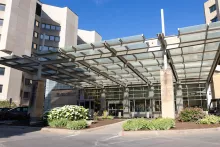Landing Zone Selection
The Landing Zone is the area used by the helicopter to land and initiate patient care. It is essential that an appropriate landing zone is selected and demarcated for the safe landing of AirCare.
- Select an area 100 feet by 100 feet for proper helicopter mobility (parking lot, highway, or field)
- Approach path, touchdown area, and departure path should be oriented into the wind
- Avoid overflying the patient, accident debris, or hazardous materials
- Clear all obstacles in the 100 feet by 100 feet area at minimum
- There should be no overhead obstacles such as wires, trees, utility poles, towers, or ground obstacles such as barricades, stumps, brush, dirt, dust, blowing snow, equipment, supplies or EMS personnel
- Select a level and firm area
- The area should be minimum 100 feet from the patient, 200 feet from spectators, and down wind from the scene if possible
Mark the Landing Zone
- To help the pilot locate the landing zone, turn on emergency vehicle beacons and light bars (avoid parking under trees or between buildings)
- To designate the landing zone during the day, use hand signals or verbal descriptions.
- To designate the landing zone at night, place lights in the corners of the landing zone and/or point headlights into the wind and onto the landing zone.
- Never shine lights up toward the aircraft
Helicopter Safety
Safety is essential around the helicopter, the heliport, and the landing zone. The following are principles that must be used when interacting with the AirCare helicopter:
- Restrict access to the landing zone and aircraft
- Keep away from the tail of the aircraft
- Secure all loose items such as hats, sheets, mattresses, supplies (don't chase items that have blown away)
- Protect eyes from blowing debris (if vision becomes impaired, crouch down instead of moving).
- Hearing protection is recommended
- Approach aircraft from pilot line of sight and only after being signaled to approach the aircraft
- No running
- No smoking within 50 feet of the aircraft.
- Never shine light towards the aircraft (risk of blinding the pilot)
- Obey commands from the pilot or flight crew
Communication Tips
Assign one person to communicate with the helicopter.
Things to communicate to the pilot include:
- Identify yourself
- Give the landing zone location
- Describe landing zone and touchdown area including the size, condition and type of surface
- Weather conditions
- Direction wind is from and approximate speed
- Obstructions in the landing zone or approach and departure paths including wires, trees, stumps, brush, towers, poles, vehicle antennas, buildings, rocks, debris, and blowing snow
- Direction of slope (if any)
- Lighting of landing zone (at night)
- Hazardous materials if present
- Emergency vehicles or equipment at scene
Flight Restrictions
Safety is paramount within AirCare’s operations. Weather conditions or other constraints may limit AirCare’s ability to fly. It is unsafe to fly in icy conditions and low visibility situations such as fog. At these times, we will do our best to help you with your transport needs by assisting you in making alternate arrangements.
Locations and Offices
